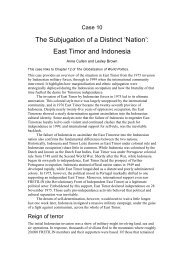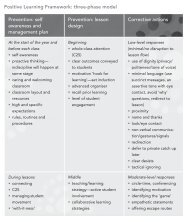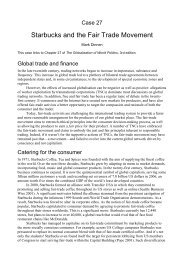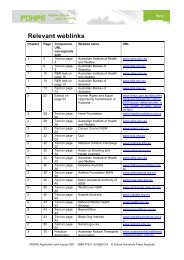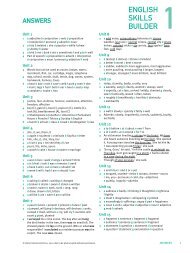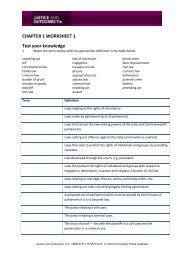2 Chapter 6 ⢠organising elements Organising elements
2 Chapter 6 ⢠organising elements Organising elements
2 Chapter 6 ⢠organising elements Organising elements
Create successful ePaper yourself
Turn your PDF publications into a flip-book with our unique Google optimized e-Paper software.
34<br />
Given the fact that so many countries do not have enough fresh water<br />
suitable for drinking, it is little wonder that many governments,<br />
including those in Australia, have decided to establish desalination<br />
plants to extract water from our oceans.<br />
They are two main methods used in desalination plants. One is<br />
based on distillation. In this case, sea water is drawn into the plant<br />
and boiled. The water evaporates, leaving all the salts behind. The<br />
evaporated water is then cooled so it condenses; it is now pure water.<br />
This is the method used in a number of Middle Eastern countries,<br />
including Saudi Arabia and the United Arab Emirates. All the<br />
pumping and heating consumes a huge amount of electricity, although<br />
some of the cost is offset by some of the valuable minerals extracted as<br />
by-products from the water.<br />
An alternative method is called reverse osmosis. This is the<br />
method used in Australian desalination plants such as the Kwinana<br />
desalination plant in Western Australia, which provides 17% of Perth’s<br />
drinking water. In this process, sea water is passed through membranes<br />
at high pressure, which removes a large proportion of the dissolved<br />
salts. The waste water from the plant, which will have a very high salt<br />
content, is pumped back into the ocean, further out to sea.<br />
Fig 6.41 Desalination plants in Australia are providing<br />
more and more of our drinking water.<br />
<strong>Chapter</strong> 6 • <strong>organising</strong> <strong>elements</strong><br />
1 Given the properties of ionic<br />
compounds, such as sodium<br />
chloride, and molecular compounds,<br />
such as water, suggest why the water<br />
evaporates away leaving the salt<br />
behind when the sea water is heated<br />
during distillation.<br />
2 Given the properties of metals, what<br />
might be a problem with all the metal<br />
parts within a desalination plant?<br />
3 Suggest reasons why distillation<br />
methods are commonly used<br />
for desalination plants in oil-rich<br />
countries such as Saudi Arabia,<br />
whereas reverse osmosis is<br />
the method used in Australian<br />
desalination plants.<br />
4 Conduct research into existing or<br />
planned desalination plants in your<br />
State or Territory and find out:<br />
a the reasons the plants have been<br />
sited where they are<br />
b the potential environmental impact<br />
of the desalination plant.<br />
UNCORRECTED PAGE PROOFS<br />
CAS_SB10_TXT_06_1pp.indd 34<br />
11/11/11 4:58 PM






